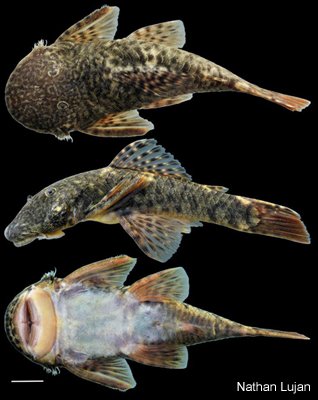| SOURCE FOR OCCURRENCE IN ECUADOR: Tan and Armbruster (2012) |
| ORIGINAL DESCRIPTION: Tan, M. and J.W. Armbruster. 2012. Transancistrus santarosensis (Siluriformes: Loricariidae), a new species with unique snout deplatation from the Río Santa Rosa, Ecuador. Zootaxa 3243: 52–58. |
| TYPE SPECIMENS: Holotype: MECN-DP 2061 (Museo Ecuatoriano de Ciencias Naturales) collected in Santa Rosa River, El Oro province in southwestern Ecuador. |
| TAXONOMIC STATUS: Newly described species. |
| RANGE ECUADOR: Known only from six specimens collected in the Santa Rosa River, El Oro province, Ecuador |
| RANGE OUTSIDE OF ECUADOR: None known. |
| COLLECTIONS IN ECUADOR: |
| MAXIMUM SIZE: Largest collected specimen in Type series is 71 mm SL. |
| DISTINGUISHING FEATURES: From Tan and Armbruster (2012): Transancistrus santarosensis can be distinguished from all other members of the Chaetostoma group by having plates at the end of the snout (except for a central region at the extreme anterior edge), but lacking plates laterally on the head (vs. either a fully plated snout or a naked snout). Transancistrus santarosensis can be distinguished from Co. platycephalus by the lack of keels on the lateral plates (vs. presence of keels on the lateral plates); from Co. platycephalus, Co. nephelion, and Chaetostoma (including Ch. platyrhyncha) by the lack of a large papilla or papillae behind the dentary teeth (vs. dentary papilla present); from Co. daguae and Co. torbesensis by hypertrophied odontodes not reaching past the gill openings (vs. hypertrophied odontodes extending to or beyond pectoral-fin spine insertion); from Co. daguae and Co. nephelion by the lack of marked undulations in the lower lip (vs. lower lip with marked undulations); and from Ch. platyrhyncha by the presence of hypertrophied cheek odontodes reaching the gill opening (vs. cheek odontodes not well-developed); dorsal fin when adpressed not reaching the preadipose plates (vs. extending to or beyond preadipose plates); five anal-fin rays (vs. two to three anal-fin rays), and typically has 8 dorsal-fin rays (the holotype has 9 dorsal-fin rays) in T. santarosensis (vs. usually 9–10 dorsal-fin rays in Ch. platyrhyncha). |
| ECOLOGY: Specific details on ecology not available. Loricariids generally are common in areas with clear, fast flowing water and hard (rocks, boulders) substrates. They feed largely on algae scraped off substrates. |
| ECONOMIC IMPORTANCE: Not of economic importance unless it has potential as an ornamental species. |
| CONSERVATION STATUS: NA. |
| LINK TO FISHBASE PAGE: Click here for link |
| SPECIES PROFILE CREATED BY: Windsor Aguirre |
| SPECIES PROFILE CONTRIBUTORS: NA |
